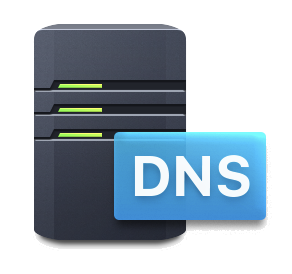Product Properties
| Package name | DNS Server |
| Application name | DNS Server |
| Volume selectable | yes |
| Dependencies | no |
| Service name (SSH) | pkgctl-DNSServer |
| Shared Folder | no |
| Home Folder | no |
| Licensing | no |
| Hyper Backup support | yes |
| Certificate selection | no |
| Privileges | no |
| Application portal | no |
| Firewall port | port 53 (all protocols) and port 53535 (UDP) |
| Date | 29 April 2021 |
| Version | 2.2.3 |
| DSM | 6.2.4 |
Functionality
The Domain Name System (DNS) helps users find Internet applications, computers, or other network devices by translating domain names into IP addresses. With DNS Server, your Synology product can host multiple zones and provide name and IP address resolution services.
Installation
Install the package DNS Server from Package Center. This adds the DNS Server application to the main menu and installs a service.

If your NAS has the firewall enabled, you will receive a firewall notification to open port 53 (all protocols) and port 53535 (UDP) after installation.
If you use Hyper Backup on your NAS, consider adding the DNS Server application to a backup task.
Prerequisite
The Synology NAS you install the DNS Server must have a static IP address on your local network. You can check and set this via Control Panel > Network > Network Interface tab. Select the network interface and click Edit.
You either set a manual configuration or choose the automatic configuration (DHCP). Still, you have made a reservation for the network interface in your network’s DHCP server, typically your internet router, or both (reservation and manual configuration).
Configuration
The configuration of a DNS Server entirely depends on what you want to achieve with it. There are three parts.
One, you configure forwarders. Two, you configure zones. Third, there are general settings for the server itself.
A zone is either master or slave and forward or reverse lookup. After creating a zone, you might want to add resource records or PTR records if it is a reverse lookup zone.
Logging and notification
The DNS Server has its logging that you find in the application.
Stop and run
You can stop and start the DNS Server service from the Package Center. Look it up among the installed packages. When Package Center opens its page with the arrow next to the button, please select it and change its status.
You can also stop the DNS Server service via SSH.
Uninstall and removal
Before uninstalling the DNS Server, ensure it is not included in any Hyper Backup backup task. Remove DNS Server from that task to prevent errors during backup.
You can uninstall the DNS Server via Package Center. As a precaution, check that the DNS Server and the installed zones are not used anymore. Clients on the network do not rely on the DNS Server.
Notes
Some good resources that can help you better understand DNS:
Rob Pickering on DNS Server: https://robpickering.com/configuring-synology-for-forward-and-reverse-internal-dns-resolution/
Synology DSM guide on DNS Server: https://www.synology.com/en-us/knowledgebase/DSM/help/DNSServer/dns_server_desc
A full installation tutorial is available on this website: Setting Up DNS Server On Synology NAS
Thanks for reading
This post is donation-ware, and I made it to help you. Please consider leaving a comment or buying me a coffee if it did. I will be eternally grateful.
Paul Steunebrink / Storage Alchemist
